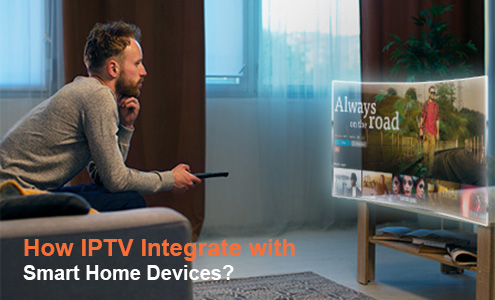
Enhance Your Experience with IPTV Services Integration:
Discover how the integration of IPTV services transforms your smart technology interaction for a seamless viewing experience.
Introduction
How to Enhance Your Experience with IPTV Services Integration Works. In the age of smart technology, the way we interact with our devices is evolving rapidly.
One of the most significant advancements in recent years is the integration of (IPTV) services with smart home devices.
This integration allows users to control their IPTV service via voice commands, through smart speakers like Google Home or Amazon Alexa.
This article explores the various facets of this integration, the benefits it brings, and how it is reshaping the IPTV landscape.
The Rise of Smart Home Devices
Smart home devices have become an integral part of modern living, providing convenience, automation, and enhanced control over various aspects of our homes. Key players in this space include:
- Google Home: A smart speaker powered by Google Assistant, capable of performing a wide range of tasks through voice commands.
- Amazon Alexa: Another leading smart speaker, Alexa, developed by Amazon, offers extensive voice control capabilities and integrates with numerous third-party services.
These devices have revolutionized how we interact with technology, making it more intuitive and accessible.
Integration with IPTV Services
The integration of IPTV services with smart home devices leverages the voice control capabilities of these devices to provide a seamless and hands-free viewing experience.
Here’s how this integration works:
- Voice Commands: Users can issue voice commands to their smart speakers to control their IPTV service. For example, they can say, “Alexa, play the latest episode of [Show Name]” or “Hey Google, pause the TV.”
- Smart Home Ecosystem: IPTV services can become part of a larger smart home ecosystem. For example, users can set up routines where a single command like “Alexa, movie time” can dim the lights, lower the blinds, and start playing a movie on their IPTV service.
Benefits of Integration
The integration of IPTV services with smart home devices offers several benefits:
- Convenience: Users can control their TV without needing to use a remote. This is particularly useful when their hands are full or when they are in another room.
- Accessibility: Voice control makes IPTV services more accessible to people with disabilities or those who find traditional remotes challenging to use.
- Enhanced User Experience: Integrating IPTV with other smart home devices allows for a more immersive and customized viewing experience. For example, users can create a home theater-like environment with the touch of a button.
- Innovation and Automation: Smart home devices allow users to automate routine tasks. For instance, they can set their IPTV to turn on automatically at a specific time or when they arrive home.
Technical Aspects
The integration involves several technical components:
- APIs: Application Programming Interfaces (APIs) are used to enable communication between the IPTV service and smart home devices. This ensures that voice commands issued to the smart speaker are correctly interpreted and executed by the IPTV service.
- Cloud Services: Many integrations rely on cloud services to process voice commands and communicate with the IPTV service. This allows for real-time responses and updates.
- Smart Home Hubs: In some cases, a smart home hub facilitates communication between different smart devices and the IPTV service, ensuring compatibility and seamless operation.
Popular Use Cases
Integration of IPTV services with smart home devices has led to several popular use cases:
- Voice Search and Navigation: Users can search for content using voice commands, making it easier to find their favorite shows or discover new ones.
- Playback Control: Users can control playback functions such as play, pause, rewind, and fast forward without needing to reach for the remote.
- Smart Routines: Users can create routines that integrate IPTV with other smart home devices, enhancing their overall home entertainment experience.
Challenges and Considerations
While the integration of IPTV services with smart home devices offers numerous benefits, there are also some challenges and considerations:
- Privacy and Security: Voice-controlled devices are always listening for commands, which raises concerns about privacy and data security. Users need to be aware of how their data is being used and take steps to protect their privacy.
- Compatibility: Not all IPTV services may be compatible with every smart home device. Users need to ensure that their chosen IPTV service supports integration with their smart speaker.
- Voice Recognition: Voice recognition technology is not always perfect and may struggle with accents, dialects, or background noise. This can lead to misinterpretation of commands and a less seamless experience.
Future Outlook
The future of IPTV integration with smart home devices looks promising, with several exciting developments on the horizon:
- Improved Voice Recognition: Advances in AI and machine learning are expected to improve voice recognition accuracy, making voice control more reliable and effective.
- Expanded Integration: As smart home technology continues to evolve, we can expect even greater integration between IPTV services and other smart devices, creating a truly interconnected home environment.
- Enhanced Personalization: Future advancements may enable even more personalized experiences, with smart home devices learning user preferences and automatically adjusting settings to suit individual tastes.
Conclusion
The integration of IPTV services with smart home devices represents a significant leap forward in home entertainment technology. By leveraging the power of voice control and automation, users can enjoy a more convenient, accessible, and immersive viewing experience. As technology continues to advance, the possibilities for further enhancing IPTV services through smart home integration are virtually limitless, promising an exciting future for both industries.

